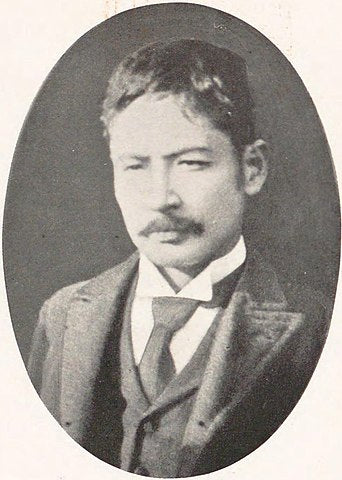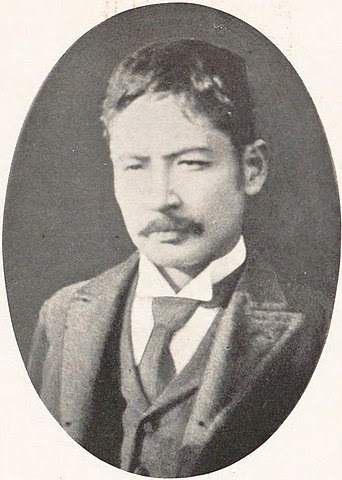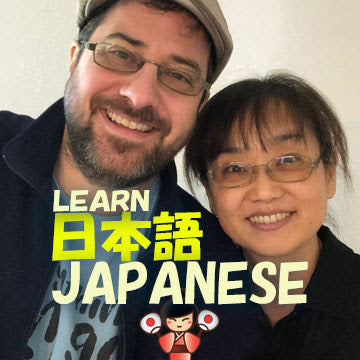Did you know Natsume Souseki (of I am a Cat and Botchan fame) was also a haiku poet? Makoto+ Shogun members, click here for today's haiku with sound and almost 100 other haiku lessons. (Not yet a member, let's fix that!)
Haiku lesson

Let's get right to it.
尼寺や 彼岸桜は 散りやすき
VOCABULARY
- 尼寺 nunnery; convent [尼 (nun) + 寺 (Buddhist temple)]
- や punctuational exclamation in haiku
- 彼岸桜 higan weeping cherry tree
- は (topic marker)
- 散りやすき easily scatter; easily fall
The scene is a quiet nunnery. The poet sees a weeping cherry tree which quickly sheds its blossoms. It is fleeting but very beautiful.
夏目漱石
夏目漱石【なつめそうせき】 Natsume Souseki wrote this poem while teaching English at the 松山中学校 Matsuyama Middle School.
Here's a picture of him from around that time period:
Natsume Souseki is best known as a novelist. He wrote books still read widely today such as Kokoro, Botchan, and I am a Cat.
We have a few totally free "sleep stories" of Yumi reading his stories while light rain falls in the background here:
https://thejapanesepage.com/
Makoto+ members (all levels) have bonus content on these sleep stories here. Right now, I only have a few up, but later today, I'll add all the Natsume Souseki content.
Let's address a few difficult words to help grasp the meaning.
彼岸桜
彼岸桜【ひがんざくら】 The higan or weeping cherry tree blossoms earlier than the more common ソメイヨシノ (Someiyoshino; Yoshino cherry tree) variety. It grows slowly but is resilient and can live longer than most other cherry trees.
彼岸
The 彼岸【ひがん】 is a Buddhist holiday that lasts seven days (a week) with the Spring equinox (the time when day and night are equal in length) stuck in the middle of the week (the 4th day). Spring equinox in Japanese is 春分【しゅんぶん】. This usually happens in March which is usually when the 彼岸桜's blossoms fall.
During the 彼岸 week, many Japanese visit graves and think of deceased loved ones. The legend has it the Spring equinox is the time when the world of the dead and the world of the living are closest.
彼 + 岸
The kanji that make up 彼岸【ひがん】 are 彼 and 岸.
First, the last kanji:
岸 means a beach, coast, or shore. Think of a mountain 山 jutting out from the ocean, creating a cliff 厂 on the dry 干 land. 干 means "dry" or "parched."
Last, the first kanji:
You might recognize 彼 as "he" 「かれ」. But another meaning for this kanji is "distant" or "over there." This is most used in the word:
As a probably (editor: totally) unnecessary side note, when I (Clay) started www.TheJapanesePage.com, while still a Geocities website (remember that?), I put out a weekly newsletter. This was probably around 1999 or 2000.
Yes, I'm that old, and my Japanese ought to be much better than it is...
Anyway, I would end my newsletters with:
Yes. This was Buzz Lightyear's catchphrase. (By the way, if you want more Buzz Lightyear phrases in Japanese (who wouldn't?!), here's a site for you: https://castel.jp/p/7180 )
I had watched Toy Story in Japanese and just had to use that phrase. So, at the bottom of every email, I wrote 「無限の彼方へ!」
My mother was a subscriber. I would label her Japanese level (then and now) as, well, rudimentary. She didn't get the reference (Toy Story) and misunderstood the meaning; she thought it was a Japanese way of ending a letter.
Cultures can be strange like that, she thought.
Using her rudimentary Japanese, she would write emails to Yumi's parents. It was a way for her to practice and keep in touch with the extended family.
That was all well and good, but ...
She ended her emails with: 「無限の彼方へ!」
After a few weeks of this, Yumi's puzzled mother asked called her up to ask what that last line could possibly mean. She wasn't a Toy Story aficionado, as it turned out.
I hope you enjoyed this haiku lesson. Even if you don't have the "sensibilities of a poet" (I can't say I do), Japanese culture and language are inseparable. Learning haiku is an excellent way to improve your Japanese.
If you are a Makoto+ Shogun or lifetime member, click here to see this lesson with audio. [Sorry, the Samurai level doesn't have access to past haiku lessons.]
Like this haiku lesson? Did you know we have almost a hundred other haiku lessons on Makoto+ now? All have vocabulary and grammar breakdowns with sound and cultural notes. Shogun and lifetime members have unlimited access to all lessons.




